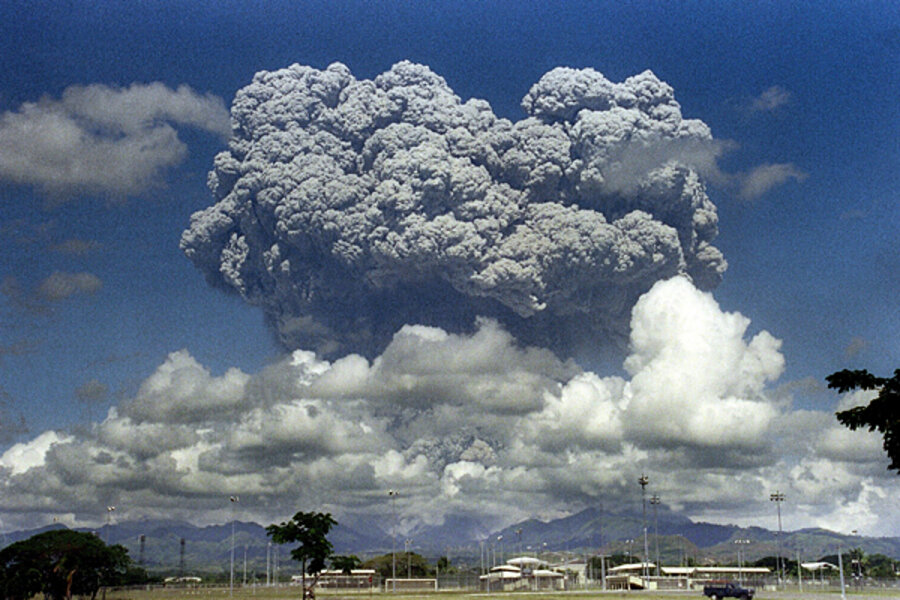Five biggest volcano eruptions in recent history
Loading...
The eruption of Eyjafjallajökull volcano in Iceland is having a major impact on travel and commerce in Europe and worldwide. But as a volcanic event, it barely rates mentioning.
By the measure of the Volcanic Explosivity Index (VEI) – a sort-of Richter scale for eruptions – the current outburst is probably a 2 or a 3, experts say. In other words, eruptions like Eyjafjallajökull happen virtually every year somewhere in the world.
The biggest eruption of the past millennium, by contrast, was a 7. Given that each number on the scale represents an eruption 10 times more powerful than the previous, that means Eyjafjallajökull is 10,000 times less powerful than one in Indonesia's Sunda Islands in 1815.
Here are the five VEI 6 and above eruptions since 1700, according to Smithsonian's Global Volcanism Program.
(For a look at Iceland's long volcanic history, click here.)
Tambora
April 10, 1815
The Tambora eruption was the largest in modern history. According to the Global Volcanism Program, it was the only eruption in at least 1,000 years to rate a VEI 7.
The eruption of Mt. Tambora in what is now Indonesia cast a veil of ash around the world, lowering global temperatures by more than 5 degrees Fahrenheit. The result was the "year without a summer" in 1816. A foot of snow fell in Quebec City, Quebec, in June. Crops failed worldwide in what historian John Post called "the last great subsistence crisis of the Western world."
The eruption is also tangentially credited with the invention of the bicycle, as the cost of maintaining horses rose, both because of the cost of oats and the death of many horses.
Krakatoa
Aug. 27, 1883
The obliteration of the Indonesian island of Krakatoa in a series of eruptions ending on Aug. 27, 1883, is, in many ways, the most famous modern volcanic cataclysm. The sound of the explosion was heard some 3,000 miles away, across the Indian Ocean on Rodrigues Island.
The VEI 6 eruption created a tsunami 150 feet tall, and a ship 50 miles away reported being blasted by hurricane-force winds from the eruption.
Volcanic ash blown high into the earth's atmosphere circled the earth in two weeks, and its lingering effects for years afterward caused brilliant sunsets that inspired artists from North America to England. In recent years, some experts have posited that the dramatic sunset in Norwegian artist Edvard Munch's "The Scream" was inspired by the effects of the Krakatoa.
Scientific study into how the Krakatoa's ash spread later led to the understanding of atmospheric winds worldwide, including the jet stream.
Novarupta
June 6, 1912
The largest explosion of the 20th century happened in such a remote area of the Alaska Peninsula that scientists trying to identify exactly which volcano erupted were mistaken for nearly a half century. Only through study local geology were they eventually able to pinpoint the eruption to Novarupta.
The VEI 6 Novarupta eruption threw out more material than all other Alaskan eruptions in history – and 30 times more than Mt. St. Helens – a VEI 5 eruption. Across the Shelikof Strait on Kodiak Island, ash fell for three days, accumulating one foot in the main town.
The eruption also caused the top of Mt. Katmai, some six miles away, to collapse. As the magma chamber under Mt. Katmai emptied through Novarupta, the weight of Mt. Katmai made it fall in on itself, forming a crater two miles wide and 800 feet deep.
Pinatubo
June 15, 1991
As the most recent VEI 6 eruption, Mt. Pinatubo demonstrated the role that science can sometimes play in limiting the damage of eruptions.
Located in the Philippines on the island of Luzon, Mt. Pinatubo had not seen any major activity for at least 500 years. But thousands of earthquakes and minor eruptions through April and May of 1991 suggested that Mt. Pinatubo was likely to erupt. Further readings suggested that gases were building within the volcano, raising the possibility of a major eruption.
Three evacuation zones were drawn up around the peak, and by the time the major eruption happened, some 66,000 people had been evacuated. Some 850 people were killed in the eruption, as compared with an estimated 92,000 after Tambora.
Curiously, direct observation of the eruption was hampered by the fact that typhoon Yunya hit the island on that same day.
Santa Maria
Oct. 24, 1902
The least powerful of the VEI 6 eruptions recorded since the beginning of the 1700s, the Santa Maria eruption hit the Pacific coast of Guatemala. The 1902 eruption was the first in the recorded history of the mountain, spewing ash that was detected as far away as San Francisco.





